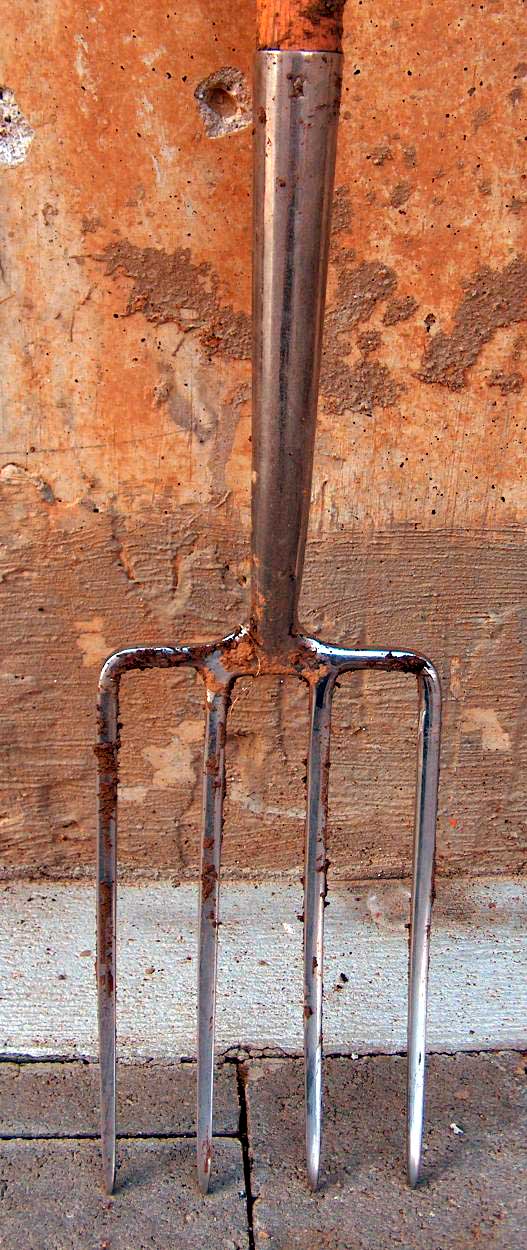Garden fork on:
[Wikipedia]
[Google]
[Amazon]
 A garden fork, spading fork, or digging fork is a gardening implement, with a handle and a square-shouldered head featuring several (usually four) short, sturdy
A garden fork, spading fork, or digging fork is a gardening implement, with a handle and a square-shouldered head featuring several (usually four) short, sturdy
 A garden fork, spading fork, or digging fork is a gardening implement, with a handle and a square-shouldered head featuring several (usually four) short, sturdy
A garden fork, spading fork, or digging fork is a gardening implement, with a handle and a square-shouldered head featuring several (usually four) short, sturdy tine
Tine may refer to:
*Tine (structural), a 'prong' on a fork or similar implement, or any similar structure
*Tine (company), the biggest dairy producer in Norway
*Tine (film), ''Tine'' (film), a 1964 Danish film
*Tine, Iran, a village in Mazandaran P ...
s. It is used for loosening, lifting and turning over soil
Soil, also commonly referred to as earth or dirt, is a mixture of organic matter, minerals, gases, liquids, and organisms that together support life. Some scientific definitions distinguish ''dirt'' from ''soil'' by restricting the former ...
in gardening and farming, and not to be confused with the pitchfork, a similar tined tool used for moving (or throwing) loose materials such as hay, straw
Straw is an agricultural byproduct consisting of the dry stalks of cereal plants after the grain and chaff have been removed. It makes up about half of the yield of cereal crops such as barley, oats, rice, rye and wheat. It has a number ...
, silage, and manure.
A garden fork is used similarly to a spade in loosening and turning over soil. Its tines allow it to be pushed more easily into the ground, and it can rake out stones and weeds and break up clods, it is not so easily stopped by stones, and it does not cut through weed root
In vascular plants, the roots are the organs of a plant that are modified to provide anchorage for the plant and take in water and nutrients into the plant body, which allows plants to grow taller and faster. They are most often below the su ...
s or root-crops. Garden forks were originally made of wood, but the majority are now made of forged carbon steel
Carbon steel is a steel with carbon content from about 0.05 up to 2.1 percent by weight. The definition of carbon steel from the American Iron and Steel Institute (AISI) states:
* no minimum content is specified or required for chromium, coba ...
or stainless steel
Stainless steel is an alloy of iron that is resistant to rusting and corrosion. It contains at least 11% chromium and may contain elements such as carbon, other nonmetals and metals to obtain other desired properties. Stainless steel's r ...
.
Reflecting their differing uses, garden forks have shorter, flatter, thicker, and more closely spaced tines than pitchforks. They have comparatively a fairly short, stout, usually wooden handle, typically with a "D" or "T" shaped grab at the end.
A smaller version of such forks with shorter, closer-spaced, thinner tines (but a full-sized handle) is known as a ''border fork'' or ''ladies' fork'', and is used for lighter work, such as weeding amongst other plants. Forks with broader, flatter tines are made for lifting potato
The potato is a starchy food, a tuber of the plant ''Solanum tuberosum'' and is a root vegetable native to the Americas. The plant is a perennial in the nightshade family Solanaceae.
Wild potato species can be found from the southern Uni ...
es and other root crops from the ground. A pair of forks back-to-back may used to lever
A lever is a simple machine consisting of a beam or rigid rod pivoted at a fixed hinge, or '' fulcrum''. A lever is a rigid body capable of rotating on a point on itself. On the basis of the locations of fulcrum, load and effort, the lever is d ...
apart dense clumps of roots.
References
* (trans. from ''Zeitschrift des Vereines Deutscher Ingenieure'', 19 Mar 1921)See also
* Garden tool * Spade * Pitchfork — for lifting loose material such as hay * Broadfork — for breaking up hardpan * Fork (disambiguation) Gardening tools {{tool-stub